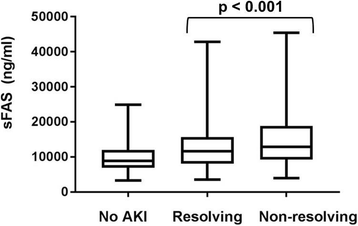Circulating levels of soluble Fas (sCD95) are associated with risk for development of a nonresolving acute kidney injury subphenotype
- PMID: 28814331
- PMCID: PMC5559814
- DOI: 10.1186/s13054-017-1807-x
Circulating levels of soluble Fas (sCD95) are associated with risk for development of a nonresolving acute kidney injury subphenotype
Abstract
Background: Critically ill patients with acute kidney injury (AKI) can be divided into two subphenotypes, resolving or nonresolving, on the basis of the trajectory of serum creatinine. It is unknown if the biology underlying these two AKI recovery patterns is different.
Methods: We measured eight circulating biomarkers in plasma obtained from a cohort of patients admitted to an intensive care unit (ICU) (n = 1241) with systemic inflammatory response syndrome. The biomarkers were representative of several biologic processes: apoptosis (soluble Fas), inflammation (soluble tumor necrosis factor receptor 1, interleukin 6, interleukin 8) and endothelial dysfunction, (angiopoietin 1, angiopoietin 2, and soluble vascular cell adhesion molecule 1). We tested for associations between biomarker levels and AKI subphenotypes using relative risk regression accounting for multiple hypotheses with the Bonferroni correction.
Results: During the first 3 days of ICU admission, 868 (70%) subjects developed AKI; 502 (40%) had a resolving subphenotype, and 366 (29%) had a nonresolving subphenotype. Hospital mortality was 12% in the resolving subphenotype and 21% in the nonresolving subphenotype. Soluble Fas was the only biomarker associated with a nonresolving subphenotype after adjustment for age, body mass index, diabetes, and Acute Physiology and Chronic Health Evaluation III score (p = 0.005).
Conclusions: Identifying modifiable targets in the Fas-mediated pathway may lead to strategies for prevention and treatment of a clinically important form of AKI.
Keywords: Acute kidney injury; Apoptosis; Biomarkers.
Conflict of interest statement
Consent for publication
No individual personal data are included in the study. All patients provided necessary consent to participate in this study.
Competing interests
The authors declare that they have no competing interests.
Publisher’s Note
Springer Nature remains neutral with regard to jurisdictional claims in published maps and institutional affiliations.
Figures

References
-
- Bellomo R, Ronco C, Kellum JA, Mehta RL, Palevsky P, Acute Dialysis Quality Initiative workgroup Acute renal failure – definition, outcome measures, animal models, fluid therapy and information technology needs: the Second International Consensus Conference of the Acute Dialysis Quality Initiative (ADQI) Group. Crit Care. 2004;8:R204–12. doi: 10.1186/cc2872. - DOI - PMC - PubMed
Publication types
MeSH terms
Substances
Grants and funding
LinkOut - more resources
Full Text Sources
Other Literature Sources
Molecular Biology Databases
Research Materials
Miscellaneous

